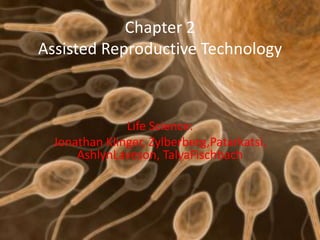
Powerpoint presentation art revised
- 1. Chapter 2 Assisted Reproductive Technology Life Science: Jonathan Klinger, Zylberberg,Patarkatsi, AshlynLaveson, TalyaFischbach
- 2. In This Presentation We Will Cover… • The male and female reproductive systems • Problems with infertility and its causes • 3 elements of successful conception • 3 methods of ART
- 3. 2.1 Where and how are sperm and eggs made? • Sperm and androgens (testosterone) are produced in the testes • Eggs and estrogen are produced in the ovaries • The gametes (sperm and egg) are both created by a form of cell division called meiosis.
- 4. 2.2 What organs make up the male reproductive system?
- 5. 2.3 What organs make up the female reproductive system?
- 6. Is infertility a common problem • Infertility is common in 1 in 6 couples • As couples grow older infertility problems increase due mostly to advancing maternal age. • 40%- male factor • 40%- female factor • 20%- unexplained
- 7. 3 elements needed for successful conception • Sperm and egg must be produced and healthy • Sperm and egg must interact to accomplish fertilization • Embryo needs a place to grow • *If one or more of these components is missing or not functioning properly infertility may result*
- 8. What are the causes of infertility in woman? • The egg • Fallopian tube • Uterus 3 things needed for a woman to conceive are…
- 9. What are the causes of infertility in men?
- 10. What is ART? • “Is the application of laboratory or clinical technology to gametes (human egg or sperm) and/or embryos for the purposes of reproduction” • We see that infertility is a common problem • ART is necessary for men and woman who are having fertility problems • ART assists so many men and woman reproduce
- 11. 3 methods used in assisted reproductive technology are…
- 12. Donation of gametes • Before the donation of eggs or sperm doctors may try to inject the woman with estrogen or the man with testosterone to help produce eggs or sperm • If the couple’s infertility problem persists, they can look to use a sperm or egg donor • Sperm is provided by known or unknown donors and may either be used immediately or frozen in a cryotank filled with liquid nitrogen -180 degrees Celsius • Couples can pick the traits they want in a donor • Eggs cannot be frozen for a long period of time. • In this procedure sperm is placed in a woman’s uterus at ovulation and if fertilized pregnancy may occur. A donated egg is usually fertilized with the males sperm in IVF.
- 15. Surrogacy • Egg donor surrogacy • The surrogates egg is fertilized by artificial insemination (IVF) using the sperm of the infertile couples male partner • The surrogate carries the embryo to term •Gestational surrogacy •The surrogate carries the embryo to term but the sperm and egg are from the couple
- 16. Advancements in ART methods • Intra-cytoplasmic sperm injection (ICSI)- used to inject a single sperm into egg • Egg freezing has now been improved • Ovaries can be transplanted from one woman to another • Pre-implantation genetic diagnosis (PGD)- Choosing an embryo without a genetic disorder that a parent may have • Transfer of gametes or zygotes directly into the fallopian tube to increase the chance of fertilization (GIFT and ZIFT)
- 17. Problems, legal, and ethical issues associated with ART • During IVF some woman hyper ovulate and produce many more eggs than expected. This is painful and dangerous • After IVF the number of embryos implanted can vary. This results in multiple births. This could be dangerous to the mother or baby. • What should be done with frozen embryos no one wants?
- 18. CASE A • Brian and Laura have been married 10 years and at first did not think about having kids • Once Laura’s sister became pregnant they realized they wanted to have a child • After trying for a year to conceive they had complications in getting pregnant • Brian wanted to adopt a child • Laura wanted a genetically related child
- 19. Questions for case A • What tests should Dr. Franco perform on Brian and Laura? • What do you think Brian and Laura should do and why? • Give some reasons why Brian and Laura should use ART? • What are some reasons to adopt instead of ART. • Give some reasons why art has become so important in the last 10 years.
- 20. CASE B • Jan Moppet wanted a child but never found found a man whom she wanted to have a child with. • At age 35, he doctor told her she should seriously think about having a child soon. • Her doctor suggested she should have artificial insemination using sperm from a sperm bank. • She ended up doing this, and had a child. • She is now thinking about what the future may hold for her and her child.
- 21. Questions for Case B • Should Jen have chosen certain characteristics in picking her sperm donor? • Should Jen tell Alex about her father being a sperm donor? • When Alex reaches age 18 should she be allowed to find her father? • If you were the sperm donor list some reasons why you would not want the child to find you.
